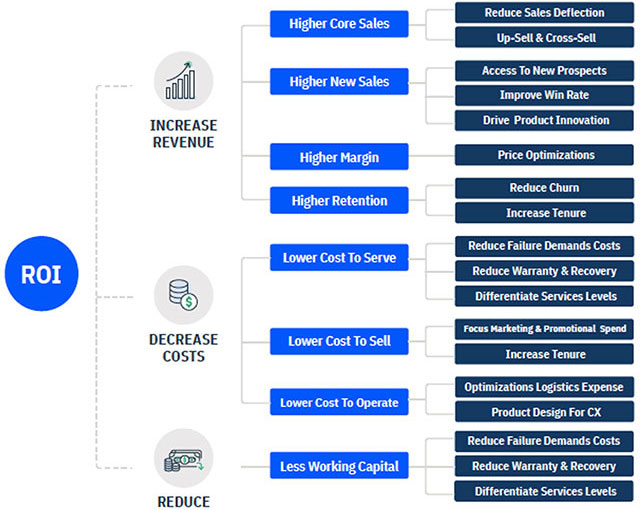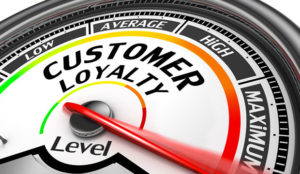Establishing a customer experience (CX) program’s ROI is one of the greatest challenges that CX practitioners and the organizations they serve face in the modern experience landscape.
Across all businesses, the entire C-suite leadership team is looking to validate an experience management program by asking one question: what is the financial impact of my CX investment?
The question is most pertinent to CFOs and other key stakeholders who are tasked with signing off on initiatives and their budgets, according to Andrew Park, vice president for strategy and enablement at InMoment.
“If you serve as CFO or in another financially-minded position, your highest priority is to protect enterprise value. The nature of your role means that you are typically direct, results-oriented, and focused on the quantifiable impact of any business investment,” he told CRM Buyer in an exclusive exchange.
Of course, you are happy to fund new business ventures for the organization. But in order to approve a business case for new technology, you will have a series of hard-hitting questions to vet a proposition before the investment is made, he cautioned.
Making a business case to the financial leaders of your company means that you have to be prepared to answer any value-based questions they might throw your way. To help you leverage the most effective answers, Park offered the most common business case FAQs to help you communicate the impact of experience initiatives on your organization.
Know Why CX Matters
Like many organizations in today’s climate, budgets are limited. Why spend money on customer experience?
Because focusing on the experiences of your customers is one of the most impactful investments you can undertake during a time of uncertainty, he responded.
Putting the customer at the center of your organization’s universe and listening to valuable feedback from every point in their journey is critical. Your business is empowered with consumer intelligence that leads to business growth through cost-saving and revenue-generating opportunities, he explained.
To make his point more visible, Park detailed a customer story about Arby’s, a fast-casual restaurant brand that has become a household name with its unique blend of quick, convenient service and mouth-watering menu items. It has seen tremendous success with its CX initiative.
Arby’s partnered with InMoment to get a better understanding of the company’s experience and what effective action it could take to improve its own CX. The result was well noted. Arby’s Overall Satisfaction (OSAT) score increased by 34 percent. Additionally, the brand saw four percent revenue growth in just one year after implementing the new CX solution.
“In addition to identifying opportunities for action from customer feedback, having the capability to listen to your employees will help you determine internal inefficiencies and opportunities to invest and divest in existing systems and processes,” explained Park.
“As business models adapt to today’s climate, this source of the employee experience data is crucial to strengthening and validating the benefits of other business cases that land in your inbox for prioritization.”
Make CX an Exception
In some cases, focused initiatives have trouble proving direct value. This makes them more of a nice-to-have rather than a business-critical program, noted Parks in leading to his next business case.
So how is customer experience an exception?
In an increasingly competitive marketplace, your brand’s customer experience will ultimately be a key long-term strategic differentiator and advantage, Parks answered. But the only way experience software can be considered a ‘must-have’ capability is if, at its core, the software enables the business’s strategic objectives.
“Of course, those will vary by industry and brand, but the functionality that makes a superior experience initiative a must-have is that it enables you to turn understanding into action,” he said.
It is important to understand that businesses cannot manage what is not being measured, he continued. But measurement alone does not affect change.
“When a business decides to put the customer at the center of the organizational universe, it needs technology to collect their feedback, analyze patterns, and most importantly, act on consumer feedback so you can realize the business benefits,” offered Park.
In an economic climate where customers are typically expecting more for less, acting on consumer intelligence is a must-have for businesses to succeed. Feedback will show you who is a detractor and how to recover them. That means you can hold onto valuable customers.
“It will show you systemic themes to prioritize and problems to solve before they become too overwhelming. And finally, feedback will expose ways to reduce costs across the business, adding to growth and profitability,” he said.
Business Implications of Customer Expectations
Park makes a striking point to bring non-believers into the fold by focusing on CX strategies. The results he quotes from the CX Network “CX Trends Report: North America” are staggering. For instance:
- 62 percent of customers have stopped doing business with a brand due to a poor customer experience
- 56 percent of customers have higher expectations for customer service now than they had a year ago
- 66 percent of customers have a more favorable view of brands that offer or contact them with proactive customer service notifications
- 95 percent of customers believe organizations should give the opportunity to provide feedback
Ensuring Success
Another business case that poses a potential obstacle for onboarding CX strategies is the question of connecting tangible value and their experience initiative, according to Park.
For example, many other organizations struggle to draw that connection. How do I make sure my business realizes the full potential of our program?
“It is no secret that many customer experience programs have not quite reached best practices. In fact, many businesses transition to a new CX platform even after they have harvested the quick wins from simply measuring customer experience,” he agreed.
Those organizations rapidly transition elsewhere because they have not been able to take action that actually improves their customers’ experiences. What also falls short is being able to directly link them to business outcomes like growth, retention, and new customer acquisition.

“Experts should be able to help you prioritize business outcomes from the very beginning, helping you intentionally design a framework that outlines the return on experience investment (ROXI).
“The financial impact of the CX capability should be outlined in the onboarding process, tested and controlled along the way, and measured and reported quarterly. As your experience management solution matures, there are multiple business benefits that can be realized,” he countered.
ROI Timetable Matters
A typical business case in this post-pandemic recovery cycle forces companies to be fiscally cautious this year. So CFOs rightfully ask how quickly they can get to ROI and justify this spending.
In a post-pandemic landscape, businesses are going to be expected to make more of an impact with fewer resources. CFOs need to be hyper-selective with investments moving forward, and in most cases, ROI is the only conversation that truly matters, responded Park.
“It takes about six to nine months to see a return on investment. In the example below, one way to show return on investment is to show the impact of a closed-loop feedback program,” he noted.
By saving one customer per month per store by contacting their detractors, a retailer was able to value the cost of each customer and arrive at a total ROI of +$2.5 million saved to this particular business, which is about 10 times.
An example of costs saved by reducing customer churn:
- Save One Customer per Month with Closed Loop Process = 12
- At Each of the Top 1,000 Locations = 1,000
- Total Customers = 12,000
- Average Customer Value = $210
- Annual Revenue “Saved” = $2,520,000
The cost of the program is absorbed by the amount of money saved through a reduction of customer churn, an increase in first-call resolution, a reduction in repeat calls, and the ability to use root cause analysis for identifying systemic issues that cause businesses to lose revenue opportunity over time, explained Park.
Another opportunity for ROI is to consolidate multiple legacy platforms such as survey platforms, dashboarding, case management, text analytics, outdated voice of employee (VoE) software, market research, and analytics functions, Park suggested.
“The best way to drive bottom-line profitability is by saving money at the top line. This gives an organization additional resources to then invest at the bottom line.
“Topline growth from an experience management perspective looks like retaining existing customers, finding new customers, and discovering opportunities to cut the costs involved with serving customers and establishing sustainable, recurring revenue,” he detailed.
A Model for Churning Propensity
Through the automated, closed-loop feedback program, organizations can use churn propensity modeling to identify and save those customers who are showing signs of discontentment, noted Park. He used one of America’s largest cable and home internet providers as a customer story example.
In an attempt to limit customer churn, the telecom giant wanted to identify at-risk customers and immediately reach out to understand the issue and retain their business. The company installed InMoment’s customer listening technology within several of its regional customer care centers to enable immediate feedback following each interaction.
Customers who give negative responses are asked if they would like to speak with a manager regarding their issues. Using real-time alerting, managers are notified of customer callback requests immediately. Three percent of all respondents request a callback, totaling 1,000 customer recovery opportunities each month for 12,000 per year, according to Park.
The average cost of a triple-play package for phone, cable, and internet is $160 per month. So the average annual value of each customer is $1,920. Using this formula, the company was presented with the opportunity to recover $23 million in annual revenue by implementing a streamlined process for identifying and rescuing dissatisfied customers, said Park.
“A voice of customer program shines a light on actions that need to be taken to rectify systemic areas of failure. It also shows the best areas to save on costs and the best drivers of customer satisfaction that will reduce the cost to serve,” he added.
Unanticipated Tasks Happen, Be Prepared
A pressing question of chief concern for CFOs crunching numbers to make CX platforms happen is, “Do I need to be prepared for unanticipated costs with an experience management investment?”
Park’s answer is, “Yes! You should always be looking for a partner that allows you to run your experience management program in the most flexible and scalable way possible. That reduces operating costs from the start.”
“While many do-it-yourself platforms require hiring a full analytics team to help you get from listening and understanding to action, this capability should be included within your program investment,” said Park.
Do not hesitate to ask your partner about a self-service solution, fully managed or a hybrid, depending on your unique business needs. This will help eliminate unanticipated costs and avoid expensive change requests, he explained.
A progressive approach to enabling a full closed-loop feedback capability across the company can minimize the gap between initial software investment and obtaining returns from an improved experience for customers.
For example, start with one known area where customers are indicating experience issues and the outcomes they are getting. Then scale from there to include other customer touchpoints areas such as inbound, outbound call centers, branch/retail, chat, or digital enablement, recommended Park.
“Another and perhaps more important question is what unanticipated costs will surface if customer feedback is not collected, not considered, and not implemented? The opportunity cost of not having an experienced management platform in place should be carefully considered, as customer-centricity has become a non-negotiable lens for businesses across all industries,” he concluded.


























































Social CRM
See all Social CRM